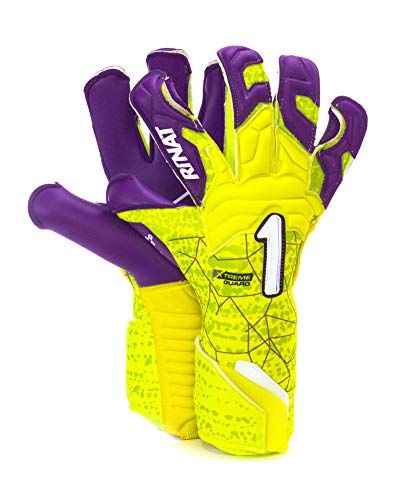Share the post "Soccer Goalies Protective Gear (Equipment/Pads + )"
Soccer goalies need equipment to protect themselves from the kicking attackers, diving headers and saves they need to make. Being a goalkeeper is tough and they need protection not only from the defense but with gear and apparel.
Soccer goalies put their bodies on the line to stop the opposing team from scoring goals. They dive, block and use any part of their body to keep the ball from going in. This position requires bravery and also some help.
Here are the key goalie protection points we will cover;
- Gloves
- Pads
- Shin Guards
- Cleats
- Caps
- Common GK Injuries
Let’s find out if soccer goalies wear protective gear to help keep them safe.
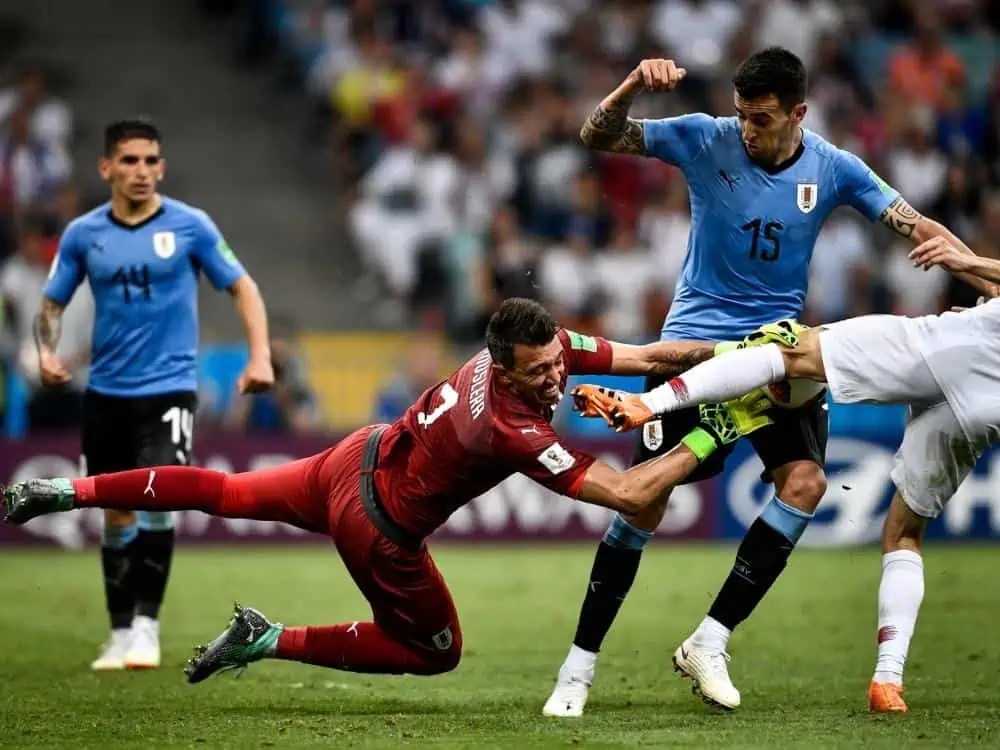
- What Do Soccer Goalies Wear For Protection?
- Do Goalies Need Gloves?
- Do Soccer Goalies Wear Knee Pads?
- Do Soccer Goalies Wear Shin Guards?
- Do Soccer Goalies Wear Cleats?
- Other Protective Gear for Soccer Goalies
- Do Soccer Goalies Wear A Skull Cap?
- Do Soccer Goalies Wear A Cup?
- Most Common Injuries for Soccer Goalies
- Protected
What Do Soccer Goalies Wear For Protection?
- Gloves
- Cleats
- Long Sleeve Jersey with Padding
- Long Pants with Padding
- Shin Guards
- Caps/Skull Caps/Cups – Optional
While every outfield player will have the same equipment, the goalkeeper will have a different color to stand out, and the kit will be slightly different. You will notice that a keeper wears long uniforms and these kits have padding on them.
The padding is light enough not to restrict the goalkeeper’s movement or make them feel heavier than they should be. It does this while providing a layer of protection between the goalkeeper and the ground.
- That said, here is a list of what you can expect a goalkeeper to wear for safety. Most soccer associations abide by or at least adopt the FIFA standards and guidelines.
Obviously, there are times when an association will have to tweak the policies to suit its needs. It is more often that these associations will add to the rules instead of reducing them.
Do Goalies Need Gloves?
Goalies need to wear gloves playing soccer at any professional level under the IFAB rules. Similar rules apply to local leagues from youth to college. The biggest tool for a goalie is their gloves. Without them, even the best goalies would look like they’ve never played the game before!
Even the best gloves compared to the worst can make a huge difference. I’ve played with a few different types of gloves before and with the lower quality ones – a shot that I would normally save will be one that slips through the fingers.
Not only are they good for the performance they give your hands protection. Your hands need to be protected from powerful shots. Top gloves give you wrist support and stability around the fingers. Which can easily be frailty when fierce shots come in.
Gloves are also used for catching crosses and punching the ball when strikers are jumping, it can become dangerous.
Below are two great options to give you that vital protection when playing in goal. Both of these options are from a highly rated professional goalie-glove-making company and you can’t go wrong.
If you’re new to soccer or don’t play too often the entry-level is good for you. If you’re playing regularly and want to succeed, the pro gloves are the ones;
Look after them well and they will be life savers. (Be sure to follow the care guide).
For a more serious GK, We’ve got a list of the best three goalie gloves – if you need the best in the business! For the best goalie gloves, these three are the top choices;
Best 3 Goalie Gloves
Product: Updated 2024-04-20 | Images: Amazon Product Advertising API | #ad - soccerblade.com is an Amazon Associate
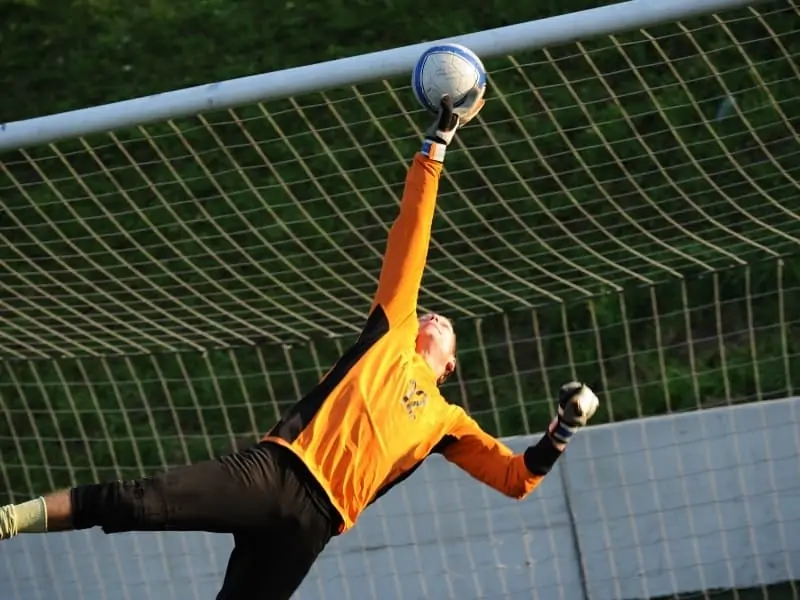
Do Soccer Goalies Wear Knee Pads?
Generally, soccer goalies don’t wear knee pads. They don’t want to be restricted during a game. However, knee pads are an optional piece of equipment in soccer.
There’s no rule against wearing them during a game. So, it’s up to the goalie to decide if they want to wear knee pads or not. That’s if the knee pads don’t pose a danger to the goalie or any other player on the field.
They can’t be made from hard material or else they could hurt a teammate or an opponent. The goalie has to wear soft padding, which won’t hurt any other players.
Although soccer goalies tend to avoid strapping on knee pads, goalie leggings are becoming more and more popular. These offer protection around the thigh and hip areas. And some include knee pads in the legging.
- Goalie leggings protect the goalie from getting injured on hard surfaces.
- They can be a good choice if the ground is hard from cold or baked hard from the sun.
And it’s always a good idea to wear them in training. That’s because you don’t want to get injured while you practice. So, goalie leggings can protect you and keep you ready for big games.
- This protective gear will give you the confidence to put your body on the line for your team while offering the best protection possible. – see the padded pants that are available at Amazon;
But knee pads aren’t the only protective gear available to goalies. Shin guards are another piece of equipment.
When Should A Goalkeeper Use Kneepads?
If you are playing at a school or casual level, then there are a few times when you might want to wear knee pads. Also, if you play indoor or street soccer on a hard surface. However, instead of kneepads, a knee brace is the better option.
That said, here are a few reasons you might want to wear kneepads or a knee brace:
- If you have an injury.
- Your knee might feel sensitive, and you want to take precautions.
- If a medical professional has advised you to do so.
- If you play indoor soccer or street soccer and you play on a hard surface.
At a professional level, no player will wear kneepads or knee braces, for that matter. There are no weather conditions or types of surfaces that would warrant this.
Also, if a goalkeeper has any injury and plays at a professional level, they will not wear a knee brace because it puts a target on their back. Yes, many people think it is sad that a player would target another player’s injury.
Still, when talking about millions of dollars at a professional level, you can’t put anything past anyone. Also, they won’t wear kneepads or braces for the reasons mentioned above in this article regarding bulkiness.
Which Sports Wears Kneepads?
Generally, in soccer, nobody wears knee pads. They are bulky and can weigh a player down. They also put a target on the player’s back.
However, there are certain sports where using your legs and feet to control a soccer ball are not so important. In these sports, players might wear knee pads. These sports include:
- Basketball
- Volleyball
- American Football
- Tennis
- Hockey (More likely a knee brace)
Why Soccer Goalies Do Not Use Kneepads
The primary reason soccer goalies do not use knee pads is to restrict their movement and hamper mobility. The safety values that it offers do not outweigh this restriction. Goalkeepers are not the fastest players on the pitch, but they need to be able to transition as fast as they can.
A soccer goalkeeper needs to backtrack; they need to shift their body weight and make quick adjustments to their position. Doing all of his would become a bit harder if they had kneepads on. Mobility is critical in soccer, especially when you play at a high level.
Also, kneepads are bulky, which could make a goalkeeper feel heavier than they are. That bulkiness also poses a threat.
The clothes a goalie wears are padded, the grass is relatively soft, but kneepads are kind of hard. So, they might have a negative effect instead of a positive one.
Yes, knee injuries in soccer do occur. However, for goalies, it is not as common as it is with outfield players. See, goalkeepers have their own safety issues to worry about, and we will discuss them further in the article.
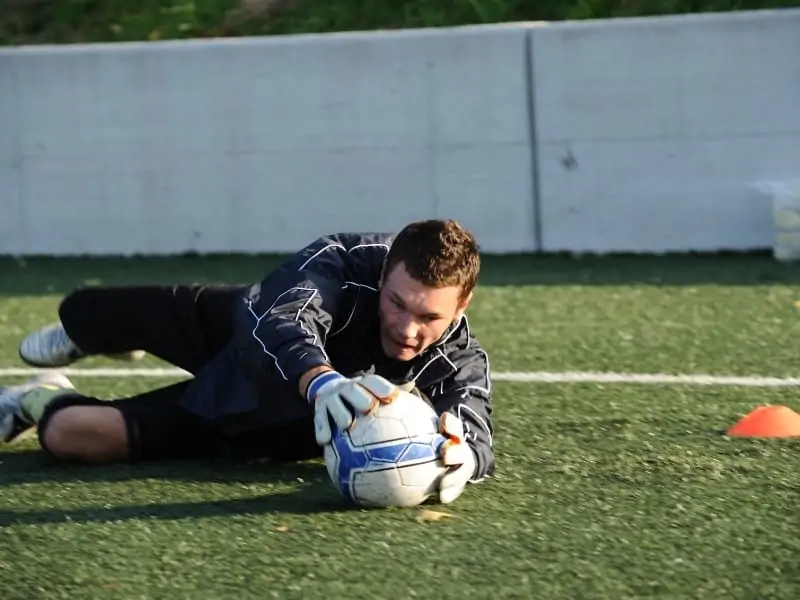
Do Soccer Goalies Wear Shin Guards?
Yes, soccer goalies wear shin guards. In fact, shin guards are mandatory for all players on the field, including goalies. However, soccer goalies don’t have to wear a particular style of shin guards. That is, there’s no specialized shin guard for soccer goalies.
So, goalies should find shin guards that are comfortable for them. Goalies have to be light on their feet. Therefore, they’ll want lightweight shin guards.
Also, goalies do a lot of bending and jumping, and diving. If you’re a goalie, you’ll want shin guards that don’t restrict your movement.
As we said before, goalies put their bodies on the line to protect the goal. This can mean diving in front of a speeding ball. But it can also mean sliding toward an attacker to stop them from shooting. This can put your lower legs at risk.
That means you’ll want strong protection for your shins. It’ll give you peace of mind when you’re challenging for the ball in your 18-yard box.
Find the best shin guards for you. Try them on if possible and see how they feel. Remember, you’ll want to be comfortable with the shin guards you choose.
One of the best things I bought for soccer was shin guards with ankle protection! They take a few more seconds to put on, but you feel protected in challenges. Have a look at these cheap Adidas shin guards;
- Shin pads with ankle guards
- EVA backing for optimal comfort
- Adjustable hook-and-loop strap for easy on and off
Product: Updated 2024-04-18 | Images: Amazon Product Advertising API | #ad - soccerblade.com is an Amazon Associate
Do Soccer Goalies Wear Cleats?
Yes, soccer goalies wear cleats. They do so for their safety and to maximize performance. Soccer cleats are made to offer protection for soccer players. This applies to goalies as well.
As mentioned in the previous section, goalies can be sliding out and tackling for the ball on occasion. Soccer cleats offer protection in these situations.
Also, goalies wear cleats to maximize performance. We already know that goalies jump and dive to protect the goal. Goalies need to have good traction with their feet.
If they’re playing in wet conditions, they need footwear that’ll stop them from sliding and losing their footing. If a goalie goes to dive for the ball and slips, there’s a bigger chance an attacker’s shot can go into the goal.
So, it’s important that the goalie’s performance isn’t affected by their footwear. The right cleats will ensure that the goalie can perform well. Additionally, goalies kick the ball a lot. They take goal kicks, hit long and short passes, clear the ball away when there’s danger.
This means they need footwear that’s powerful and will stand up to this pressure. And cleats are built for that purpose. But that’s not all. Goalies are on their feet for the whole game. They need to have comfortable footwear.
Cleats are designed to provide comfort for soccer players during a game. Because goalies are soccer players, this applies to them, too. So, goalies wear cleats while playing soccer.
Here are two solid choices of cleats for goalies;
You’ll want to see from the features which is the best choice for you.
Other Protective Gear for Soccer Goalies
In soccer, goalies can also wear protective headgear. This usually happens if they get an injury to their head. Petr Cech, formerly of Chelsea, is one famous example of a goalie wearing protective headgear. He started doing this after an injury.
In 2006, during a Premier League game, Cech collided with Reading midfielder Stephen Hunt in his 18-yard box. He got a head injury and needed surgery for a depressed skull fracture.
Due to the injury, Cech wore protective headgear while playing.
He could wear the protective headgear because it didn’t put anyone in danger. For instance, he couldn’t have worn a football helmet for protection. Such hard material could put players in danger.
Cech wore headgear made from soft padding. It offered him protection without putting other players in danger. You can see what it looks like below:
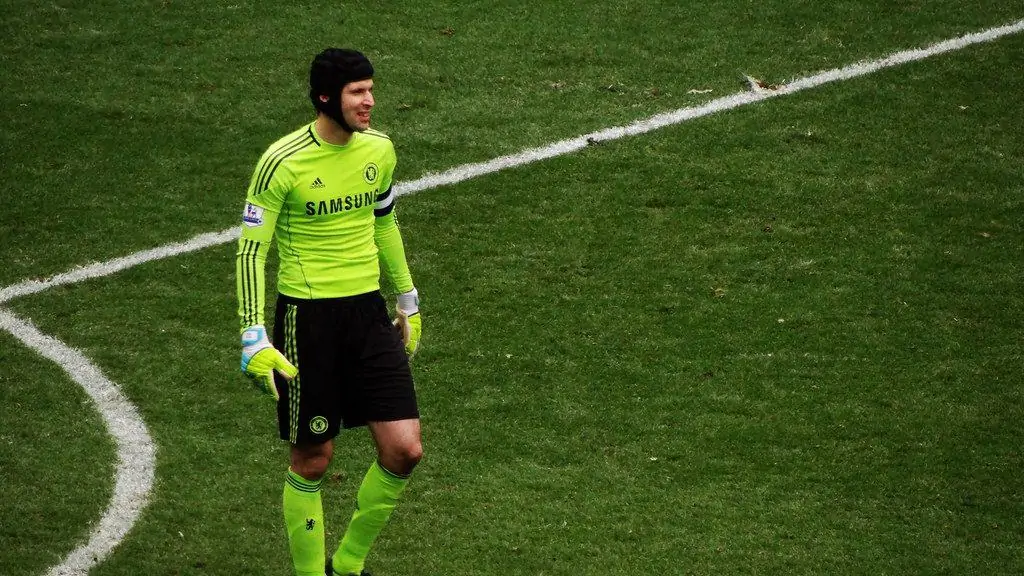
There we have it, our guide to soccer goalies and protective gear. It’s a good idea to choose what’s comfortable for you. But you also want to think about protection.
So, weigh up your options to stay comfortable and protected.
Do Soccer Goalies Wear A Skull Cap?
Most keepers that wear skull caps only do so because medical professionals advise them to do so. The skull cap can make a goalkeeper’s job a little more complicated because it impacts their hearing and overall mobility.
So, while it is rare to see any player with a skull cap if you see a keeper wearing one, they were likely involved in an incident that poses a significant threat to their well-being.
Below is an interesting video by “Oh My Goal” explaining why Petr Cech, a premier league legend, wears a skull cap.
But why does Petr Čech always wear a helmet? – Oh My Goal
Do Soccer Goalies Wear A Cup?
A few high school soccer players might wear a cup at the beginning of their playing days. Still, with years of experience, I have never heard of or seen professional soccer players or amateurs wearing a cup.
Wearing a cup could affect the player’s ability to adjust their body at certain angles. It could also affect the player’s ability to kick the ball accurately.
A cup may not seem like a big deal in sports where you use your arms or hands to handle the ball, but it makes a huge difference in soccer.
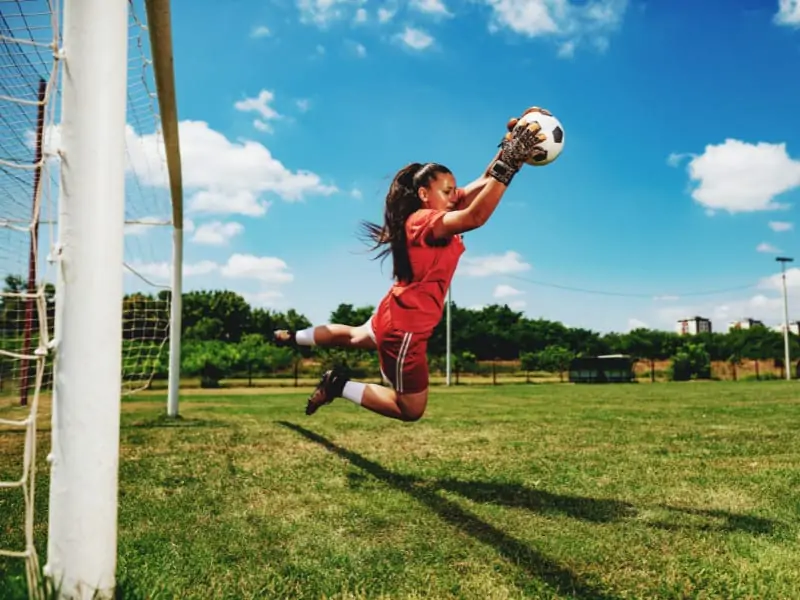
Most Common Injuries for Soccer Goalies
All soccer players risk picking up pretty much any injury possible. However, the outfield players are more concerned about lower-body injuries to the hamstring, knees, or ankles from the defenders to the strikers.
Soccer goalkeepers are typically more concerned about upper-body injuries.
So, you can consider that to be another reason why they wouldn’t concern themselves with wearing kneepads. They also don’t wear elbow pads, though, just in case you were wondering.
Again, that would restrict movement. Let us take a look at and discuss a few of the most common injuries that affect goalkeepers.
Do Soccer Goalies Get Knee Injuries?
Soccer goalies do not typically jump onto their knees. Instead, they land on their shoulders using the arm to absorb the impact.
When they go to the ground to save a low shot, they might drop to their knees, but they have padding on their uniform, so there is no need for knee pads for a goalkeeper.
Soccer goalies can experience knee injuries. However, this does not typically come from their knees making contact with the ground.
Obviously, this can happen in some instances, but it usually does not. Here are a few reasons a goalkeeper might experience in knee injury:
- Collision with another player.
- Awkward landings.
- Sudden changes in angle and direction of the knee.
Common types of knee injuries for soccer goalies:
- ACL tear (This is common in soccer, for all players)
- Torn meniscus: This happens when you twist your knee.
As you can see, these types of injuries have less to do with impacting the ground and more to do with twisting the knee or having a player collide and have their knee bent to the point that the ACL will tear.
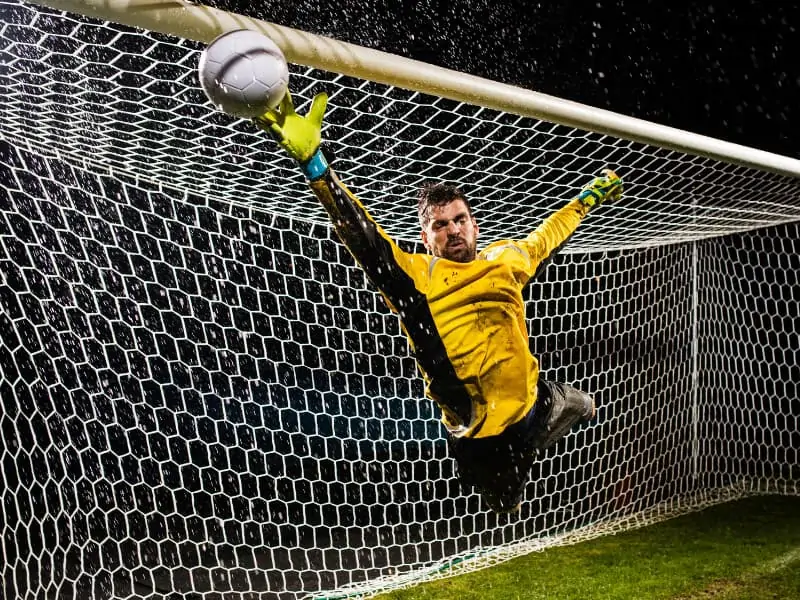
Head Injuries
When a goalkeeper goes to the ground, they risk getting kicked or kneed in the head. Remember, the goalkeeper has a primary objective to keep the ball out of the net, and they will often put this objective before their own well-being.
Another cause of head injuries is when a goalkeeper collides with another player while jumping in the air.
When you have a solid and fast player charging at you, and you go to the ground to secure the ball, it can be scary. The most common goalkeeper head injuries include:
- Concussion
- Bruising
- Lacerations
- Fractures (Jaw, skull, or nose fracture)
Elbow And Shoulder Injuries
As tall as goalkeepers usually are, they can’t reach out their arms and stop every shot that comes at them. To get to the top corner to block a shot, keepers will jump in the air.
While they are trained to land safely, mistakes do happen, and they can often land uncomfortably. A soccer goalie is not going to injure their shoulder or arm by simply blocking a shot.
It often happens due to a bad landing or collisions either with their goalposts or another player.
A study that analyzed these types of injuries concluded that goalkeepers are far more likely to be affected by elbow and shoulder injuries than outfield players.
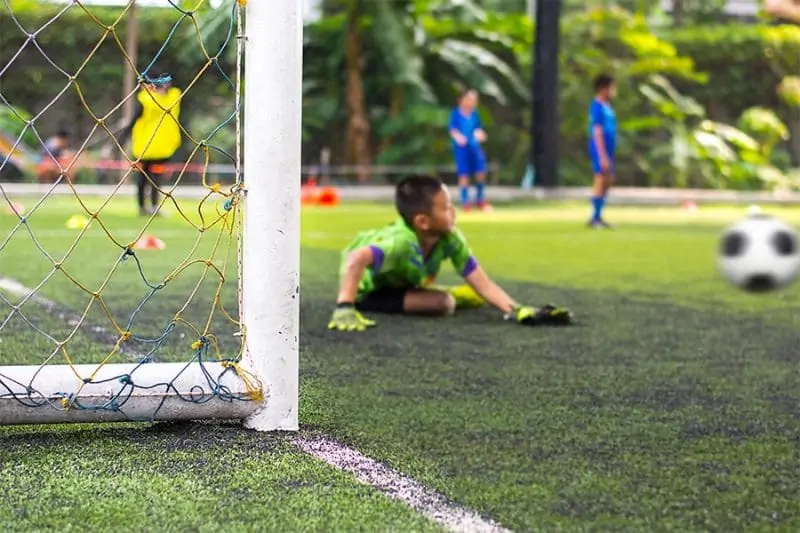
Hand Injuries
Again, a goalkeeper is not necessarily going to hurt themselves by stopping or catching the ball; that is a misconception. Remember, their gloves provide significant protection for their hands.
A hand injury often occurs from player collisions or if a goalkeeper’s hand gets stepped on, which does happen in football, but not on purpose in most cases. Still, when the adrenaline is pumping, anything can happen.
Leg And Ankle Injuries
It is not often that a goalkeeper hurts their legs. However, it is not rare to see a goalkeeper hurt their ankles.
See, a goalkeeper spends a significant amount of time tracking backward and adjusting their position at high speed. This can cause ankle injuries such as sprains.
Protected
Playing as a goalkeeper is one of the most dangerous on the field. You have the biggest players around you trying to protect your goal and ones trying to score – and they will do anything to score!
Compared to some sports, the equipment for soccer is little and cheap. Get the protection you need, and you’ll be safe and more confident in front of your goal.
Another thing for safety is knowing your rules as a goalkeeper, check out this article to know the ins and outs of Goalkeeping Rules.
Sources
- Torn Meniscus: https://www.mayoclinic.org/diseases-conditions/torn-meniscus/symptoms-causes/syc-20354818#:~:text=The%20meniscus%20is%20a%20C,the%20most%20common%20knee%20injuries.
- ACL: https://www.mayoclinic.org/diseases-conditions/acl-injury/symptoms-causes/syc-20350738#:~:text=An%20ACL%20injury%20is%20a,to%20your%20shinbone%20(tibia).
- More on goalkeeper injuries, including knee: https://activekidmd.com/soccergoalkeepers/
- Shoulder and elbow injury, source already in the article: https://pubmed.ncbi.nlm.nih.gov/29618228/
- Equipment: Please see pages 16 – 18 from the official FIFA handbook. https://digitalhub.fifa.com/m/4028a792bb93a722/original/q3drmdesvc8bbmanff8d-pdf.pdf
Share the post "Soccer Goalies Protective Gear (Equipment/Pads + )"
Joel is a seasoned soccer journalist and analyst with many years of experience in the field. Joel specializes in game analysis, player profiles, transfer news, and has a keen eye for the tactical nuances of the game. He played at various levels in the game and coached teams - he is happy to share his insight with you.


